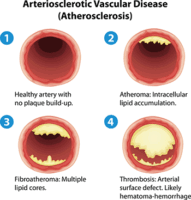What is vascular aging and poor blood circulation? This can be divided into two parts: (1) Vascular aging: refers to that the lumen of the blood vessel becomes uneven, the elasticity of the blood vessel becomes poor, and even calcification and hardening occur, and the blood does not flow smoothly in the lumen, and even in severe cases Thrombosis and obstruction, causing severe hypoxia in the supply area, cell, tissue, organ failure and necrosis. (2) Poor blood circulation: Refers to the viscous and turbid blood, poor fluidity, low oxygen content, slow blood flow in the lumen, resulting in hypoxia in the supply area, and removal of metabolic products The ability of carbon dioxide and carbon dioxide is reduced, and the chance of thrombosis is also relatively increased.
Rrterial aging process:

- Normal arteries have smooth lumen and smooth blood flow.
- Cholesterol deposits slowly appear in the lumen with age or dietary pattern.
- The deposited part will gradually form atherosclerotic plaque, the lumen will become uneven, and the blood flow will start to be unsmooth.
- Atherosclerotic plaques get bigger over time, and the lumen becomes narrower, making blood flow less smooth.
- In some cases, an atherosclerotic plaque ruptures suddenly, causing the blood to clot and block the blood vessel, interrupting blood flow.
Arterial aging cross section:

- Healthy arteries have smooth lumen.
- Cholesterol deposits appear in the lumen and atherosclerotic plaques begin to form.
- Over time, atherosclerotic plaques grow larger.
- The lumen is getting smaller and smaller, and it is easy to cause thrombosis.
Arterial vascular aging and poor blood circulation occur in various organs and tissues of the body and their characterization:

- Vascular aging in the brain: Ischemic stroke.
- Poor blood circulation in the brain: Poor spirit, inability to concentrate, sleep disorders, atrophy of brain nerve cells, memory loss or loss, and even incoordination of peripheral neuromuscular movements.
- Ocular Vascular Aging: Eye Stroke, Vision Loss.
- Poor blood circulation in the eye: Optic nerve cell degeneration, blurred vision, reduced night vision, cloudy lens, dry and sore eyes, photophobia.
- Cardiovascular aging: Angina pectoris, myocardial infarction.
- Poor blood circulation in the heart: Irregular heart rhythm, palpitations, myocardial weakness, insufficient blood propelling force, resulting in the involvement of peripheral circulation.
- Renal vascular aging: Chronic renal insufficiency, renal hypertension.
- Poor renal blood circulation: Decreased renal function, decreased blood clearance rate, and increased accumulation of toxic substances in the blood.
- Intestinal vascular aging: Ischemic bowel disease.
- Poor intestinal blood circulation: Poor intestinal peristalsis, impaired absorption and digestion, and even poor bowel movements.
- Vascular aging in joints: Ischemic bone lesions.
- Poor blood circulation in joints: Joint pain, weakness and degeneration, affecting normal flexion and extension functions.
- Acral vascular aging: Ischemic gangrene.
- Poor blood circulation in the extremities: Paresthesia or numbness, and even intermittent claudication, especially in cold weather or at night. In addition, the skin will also appear dry and rough, cracked, scaling, itching, severe keratinization, and pigmentation.
